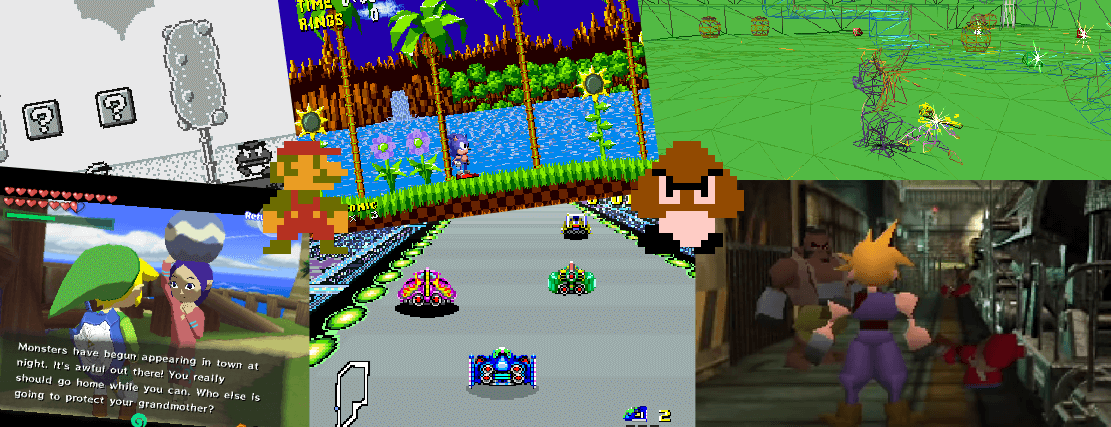
可用語言: 🇬🇧 - English, 🇭🇺 - Magyar, 🇩🇪 - Deutsch, 🇵🇱 - Polski, 🇨🇿 - Čeština, 🇩🇰 - Dansk, 🏴 - Galego, 🇪🇸 - Español, 🇧🇷 - Português (Brasil), 🇮🇩 - Bahasa Indonesia, 🇹🇷 - Türkçe, 🇫🇷 - Français, 🇮🇹 - Italiano, 🇷🇺 - Русский, 🇺🇦 - Українська, 🇦🇪 - اَلْعَرَبِيَّةُ, 🇯🇵 - 日本語, 🇨🇳 - 简体字, 🇹🇼 - 正體字, 🇰🇷 - 한국어, 👋 - 新增翻譯

電子遊戲主機的進化史是如此地迷人。 一直以來個人電腦都是採取「逐步漸進」地發展方式,然而新世代的遊戲主機卻呈現了另一種截然不同的樣貌。 您將在這裡看到一系列文章,為您揭示最新技術趨勢背後的原理。 同時還將說明為什麼每個系統不能單純地用「xx 位元」、「oo 兆赫」、或是記憶體的大小來概括其性能。
這不是開發手冊,只是對每個系統內部運作方式的深入介紹。 請記住,技術隨著時間發展到非常複雜的程度,所以如果您對最新文章的理解感到吃力,或許可以先讀讀更早的文章。 這些文章介紹了許多概念和定義,以及在技術的發展中,這些概念與定義也經常地被重新審視。
儘管閱讀本書最好有基礎的計算機知識,但我仍盡力讓內容能夠通俗易懂,所以不用害怕嘗試! 但若仍遇到不懂的地方,也可以先翻翻這個 相關閱讀材料。
雖然我行文力求準確,但如果您發現任何錯誤,請 與我聯繫。 最後,如果您偏好使用電子書閱讀器閱讀,請查看電子書版本。
話不多說,讓我們開始吧!
Known as '8-bit' consoles, these machines brought more sophisticated graphics and richer sounds than their predecessors. After all, a big market crash just occurred and newer standards had to be set.
優秀的GPU特性: Scrollable tile maps and larger colour palettes.
DMA, horizontal interrupts, multiple modes... These are some examples of the new concepts that brought the new '16-bit' generation, opening the door to new genres of games.
顯著的CPU進步: Multiplication and division instructions, DMA and dual-processing.
優秀的GPU特性: Affine transformations and horizontal interrupts.
3D gaming has become a need but 'how' is not clear yet. The response? Every company presented their own different vision.
顯著的CPU進步: Pipelined datapaths and L1 cache.
優秀的GPU特性: Programmable vertex pipelines, Z-buffering and perspective corrections.
Most of the graphics limitations from the previous generation are no more. Portable consoles start to resemble familiar systems.
顯著的CPU進步: Superscalar architectures, SIMD instructions and L2 cache.
優秀的GPU特性: Programmable pixel pipelines and anisotropic filters.
Consoles have evolved into supercomputers and multimedia hubs. These machines are now more capable than just playing games, which is why security is now a critical factor.
顯著的CPU進步: Thread level parallelism and symmetrical multi-core architectures.
優秀的GPU特性: Unified shader model and HDR rendering.
The entertainment market has now been conquered by cheap smartphones and tablets. Social media capabilities become the first priority of every peripheral. It's time for traditional video-game companies to renovate their status quo, and they better do it quick.
有很多遊戲機我可以寫關於... 如果你想知道我的下一個列表是什麼,這就是:
#### Personal computers repackaged as consoles
如果你發現我的文章有趣,那麼請考慮捐款。你的貢獻將被用來購買工具和資源,這將幫助我提高現有文章和即將發表的文章的質量。我也在每篇文章的末尾提供一個有趣的材料獲取清單。


您也可以購買英文的電子書版本。我將利潤視為捐款。

作為感謝的象徵,您的名字將被包含在下一篇文章或您提名的文章的致謝部分,除非另有說明。
If you want to know more about this series, here I've compiled common questions that people have asked me in the past.
Because I believe it’s the best way to properly comprehend present (and future) technology. Current advancements don’t pop out of nowhere, they may even carry past technology that only became popular many years later. Moreover, learning the fundamentals also allows me to filter misinformation out (which I’ve seen plenty of).
Apart from that, it’s continuous food for thought.
Definitely! I already started compiling the series and actively expanding. Furthermore, if you’re an editor/publisher and would like to work together on this, please get in touch.
Chances are I’d like to, however, time and budget are my main constraints.
Please open an issue on the Github repo so I can review it (and other people can contribute as well).
I don’t mind being wrong! But I can only do so much if people keep the corrections for themselves or only discuss them on a separate forum.
The point of the articles is so you can form an educated opinion by yourself. Although, nothing beats the Nintendo Switch U 64 OLED!
You can also check out the about page or drop me a line.